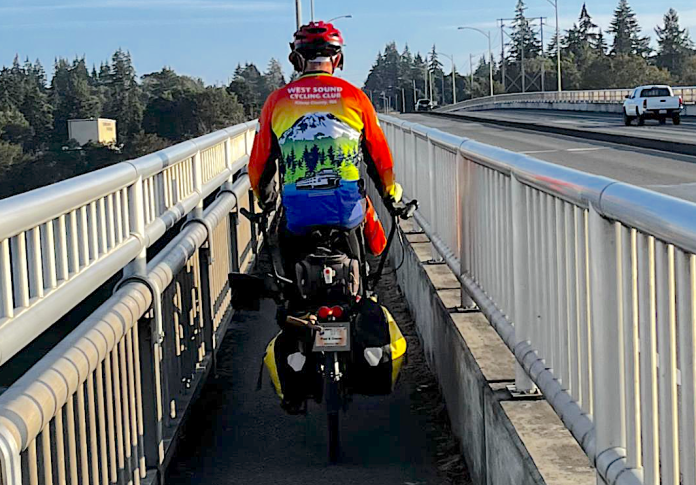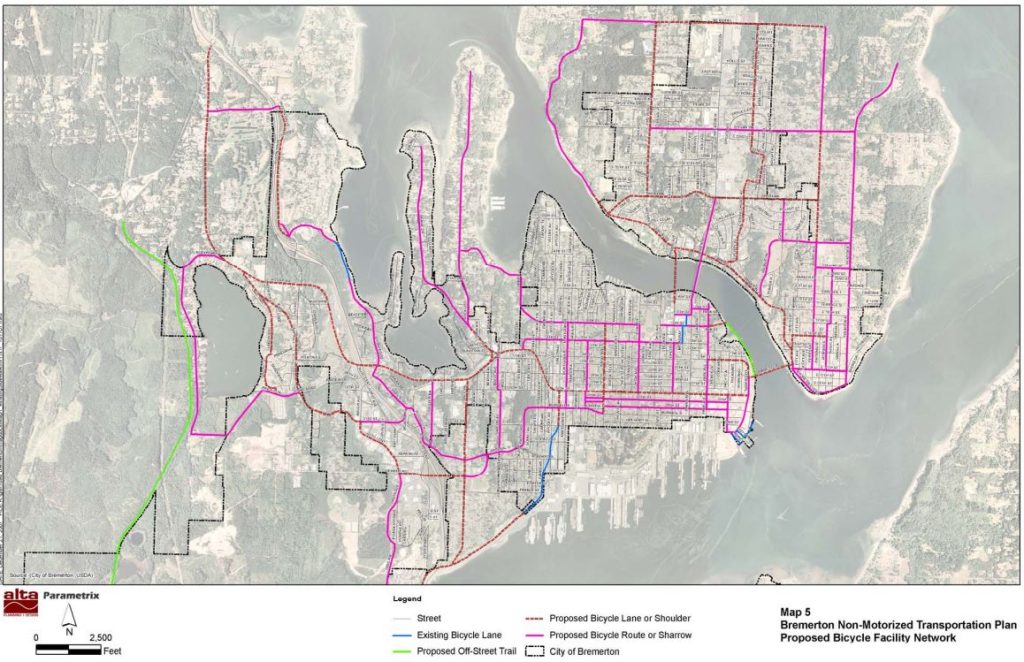
It’s time to decide on Bremerton’s Warren Avenue Bridge bike and pedestrian trail. After years of study, the debate is whether the east side trail on State Route 303 should be 12-foot wide (preferred by multimodal advocates) or whether to accept the Wheeler administration’s preference of 10-foot wide. Public Works and the city council president have written dueling resolutions and the council will vote on Wednesday.
With a myopic focus on the 0.4-mile bridge span, reasonable people can disagree about 10-feet versus 12, both are a big improvement from the status quo (currently a claustrophobic 3.5 feet on both sides). But the 12-foot span is clearly superior if one expands their vision beyond the bridge itself and considers the future, city-wide multimodal network.
Ten-foot multi-use paths are too narrow. Bremerton’s other big bridge, the Manette Bridge has one, but it also has bike lanes. Mix two-way bikes and two-way pedestrian use and it’s uncomfortable for everyone. It’s too tight to pass comfortably. Modern bridges in Washington are building 12- and even 14-foot bike and pedestrian facilities.
How to Move a Growing Bremerton?
After 60 years of hardly growing at all in the city proper, planners tell us that in the next 20 years, Bremerton will add 20,000 residents (a 44% increase). And by 2028, United States Navy leaders predict 5,000 additional workers at downtown Bremerton’s Puget Sound Naval Shipyard (up 20% from the current 24,000).
The big question facing the transportation planners is: How will 44% more people get around? Since the 1950s, Bremerton’s answer has been: drive in your car. But ‘everyone in their own car’ simply does not scale with 44% more car traffic. How bad will traffic jams be with 44% more cars? Where do 44% more cars park in downtown Bremerton?
The better, more forward-looking solution is to help some of those extra people get out of their cars and onto a multimodal network that includes efficient public transit service and safe non-motorized trails. If just 10% of the Naval Shipyard’s nearly 20,000 car commuters used other options, our streets would have 2,000 fewer cars during rush hour. Better for the climate, better for Bremerton residents, a reduction in traffic and better for drivers.

But drivers will never consider alternative transportation options if these non-car options are inconvenient and unsafe. That’s why we must act with wisdom and vision to construct a robust, disaster-resistant, multimodal transportation network. Two projects critical to that network are the east side 12-foot Warren Bridge path and the 6th Street Road Diet.
Why east side?
The facility should go on the east side of the Warren Avenue because both north and south of the bridge, the bulk of northeast Bremerton’s future development will be on the east side of SR 303. East of SR 303 neighborhoods are zoned for multi-family dwellings and commercial development. The east side includes the Shipyard’s primary pedestrian gates (Bremerton Gate and the Burwell Tunnel). Just northeast of the bridge, the old Harrison Hospital District is planned as a high-density, mixed-use commercial. Meanwhile, the areas west of the bridge are zone almost exclusively single-family dwellings. The east side is where more people are now, and the city is planning for the east side to grow.
Furthermore, the future northeast Bremerton bike network is being planned east of SR 303. A large project will build a multi-use trail past Viewridge Elementary and up Almira Drive on the east side of SR 303. No bike network is being planned west of SR 303. So, putting the facility on the west would force crossing over a busy SR 303 for most to reach their destination — a time consuming and unpleasant experience.
A 12-foot, east-side Warren Avenue Bridge trail reinforces and future-proofs the east side multimodal network. A 10-foot bridge continues the bad old city-wide tradition of building mediocre multimodal improvements that aren’t comfortable for the people using them.
Bremerton is in the middle of a bike lane building spree: the Manette Bridge, Naval Avenue, W Kitsap, Almira, 6th Street and the Warren Bridge. But the future is calling. Bremerton shouldn’t simply focus on individual projects, but work to make those projects interconnected, safe and fit for purposeful use. A 12-foot east side multimodal path is consistent with the vision of a city-wide multimodal network. A 10-foot east side just continues the same old theme of disconnected and unsafe infrastructure that keeps people in their cars. City Council must act bravely and with a focus on how we want Bremerton to be decades into the future.
I urge the City Council to reject the 10-foot bridge option, and build a modern and safe 12-foot east side crossing with a vision beyond the bridge.
Three ways to voice an opinion at the meeting:
- Attend the Bremerton City Council meeting, Wednesday, August 2nd, 5:30pm at Bremerton City Hall.
- Comment during the meeting virtually: https://www.bremertonwa.gov/691/Council-.
- Email: city.council@ci.bremerton.wa.us.

